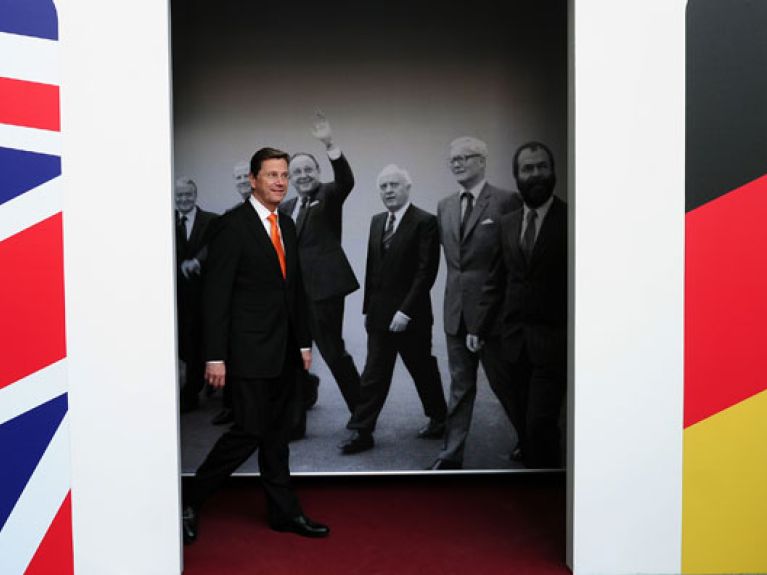Achieving Unity

The division of Germany was the price it had had to pay for its campaign of conquest, pillage and destruction during the years from 1939 to 1945 – and it was also a consequence of the differing views on the German question among the victorious Allies. Originally planned as the demarcation line between Soviet and American, British and French occupation zones, over the years the line between Lübeck, Helmstedt, Eisenach and Hof became a frontier between two German states. In summer 1961 the rulers of the East German regime transformed it into a practically impenetrable barrier by installing the Wall, barbed wire and minefields.
It did not only separate the Federal Republic of Germany, which had been founded in May 1949, from the GDR, which was founded a few months later. Anyone who wanted to make the Wall passable or even overcome it, had to acknowledge the consequences of the Second World War – and needed the consent of the victorious Allies. A first step was taken by the German Federal Government between 1970 and 1972: in treaties with the Soviet Union, Poland and the GDR, among other things, Bonn confirmed the fact of German division and accepted the border along the Oder and Neisse rivers as Poland’s western frontier.
The second step required a change in the Soviet Union’s attitude to the German question. That was considered impossible until a new general secretary of the Communist Party, Mikhail Gorbachev, began an equally radical and transparent reform of the waning empire. What was planned as a process of internal renewal, soon developed its own revolutionary momentum that the Kremlin could no longer control. Reform led to secession, and this sooner or later gripped all the peoples of the Soviet Union and its sphere of influence in Europe, including the population of the GDR.
However, because the state and party leadership in East Berlin rejected reform, ordinary people sought refuge in flight. Their path took them to neighbouring Czechoslovakia and from there to Austria via Hungary. While the Hungarian reformers signalled their support and announced the opening of their border to Austria on 10 September 1989, the leadership of Czechoslovakia took the opposite course and closed its frontier with Hungary.
As a result, Bonn’s embassy in Prague became a place of sanctuary for the would-be emigrants. By the end of September some 5,000 people were holding out in the grounds. A similar development began in Warsaw. It was an untenable situation. After Hans-Dietrich Genscher found a solution on the fringes of the United Nations General Assembly in New York, on the evening of 30 September he was able to announce to the people assembled in the gardens of the Prague embassy that they would be allowed to leave for the Federal Republic. In accordance with one of the GDR’s conditions, their journey was completed in special trains that travelled through its territory. That turned out to be a foolish demand since the refugee trains from Prague and Warsaw only increased the pressure on the regime. Even the fall of Erich Honecker, the general secretary of the SED, did little to change that.
Hundreds of thousands now took to the streets – with unrestricted travel not the least of their demands. On the evening of 9 November the SED information secretary wanted to make a statement. Asked when the new travel law would come into effect, Günter Schabowski answered – in front of rolling cameras and clearly under pressure – “immediately, without delay”. That triggered a mass movement of people towards the Wall, which in turn became the beginning of the end of the GDR. Towards 10:30 p.m. the border soldiers gave in to the pressure and raised the first barrier at the Bornholmer Strasse crossing point.
Although the Wall had barely opened, the citizens of the GDR left no one in any doubt about where the journey was heading. Politics had to respond. On 28 November 1989, the federal chancellor made a statement to the Bundestag that became famous as the Ten Point Plan. Looking back on history, Helmut Kohl did not consider “German unity” a realistic short-term goal, but “confederative structures” appeared feasible.
Less than eight weeks later, the pressures on the political actors at home and abroad had increased so much that unification now only appeared a matter of time. These concerns were discussed by the foreign ministers of the two German states and the four Allied powers of the Second World War when they met in Ottawa for consultations between NATO and the Warsaw Pact on the question of aerial observation. On 13 February 1990 the Six stated that they wished to discuss the “external aspects” of German unification. In mid-March the political directors of the foreign ministries began preparing these consultations, and on 5 May the six foreign ministers met in the Weltsaal at the Federal Foreign Office in Bonn for their first round of talks. Present alongside host Hans-Dietrich Genscher and the foreign minister of the first freely elected GDR government, Markus Merkel, were James Baker for the USA, Eduard Shevardnadze for the Soviet Union, Douglas Hurd for the UK and Roland Dumas for France.
The group considered the Germans’ ideas. That applied not least to the designation “Two Plus Four” – rather than the other way around. The small circle of participants was also in the Germans’ interest since it was clear that these were not talks on a peace treaty. Then it would possibly have been necessary to involve all the roughly 40 states that had been at war with Germany when it declared its unconditional surrender. The first talks were followed by three further meetings: in Berlin-Niederschönhausen – in other words, in the eastern part of the city – on 22 June; in Paris on 17 July and finally in Moscow on 12 September 1990.
The proceedings were not always harmonious and the six were not always alone. For example, the Soviet foreign minister unexpectedly presented a draft treaty in Berlin that said Germany would only receive its full external sovereignty years after internal unification – an idea that the Bonn foreign ministry totally rejected. Incidentally, this did not affect the good relations between them.
On the other hand, the Paris meeting was the only one in which a seventh party occasionally also took part – the Polish foreign minister, Krzysztof Skubiszewski. With good reason, too, since the history of Poland since the 19th century had been the history of its occupation, partition and relocation by foreign powers. Almost always involved were Prussia and, later, the German Reich. On 21 June 1990, in identical statements, the Bundestag and the People’s Chamber of the GDR confirmed the “inviolability” of the German-Polish border “now and in the future”. The door to Poland’s acceptance of unification was opened by the Federal Government’s pledge that the united Germany would also internationally recognize the border along the Oder and Neisse rivers in a treaty with Poland.
Strictly speaking, from the very beginning, the Two Plus Four process was part of a more wide-ranging marathon of talks and negotiations. They focused above all on the question of united Germany’s membership of the international organizations to which the Federal Republic of Germany had previously belonged. That was unproblematical in the case of the United Nations, of which both German states had been members since September 1973.
More difficult was the question of how to integrate the GDR into the European Community as part of a united Germany. It was Jacques Delors, president of the European Commission, who eventually prepared this without any changes in its treaties. Incidentally, the unification of Germany contributed to the accelerated realization of the European economic and monetary union agreed in June 1989 – and with it the relinquishment of national currencies, including the deutschmark. The reestablishment of German unity and the advancement of European union were two sides of the same coin.
What proved to be the greatest hurdle was united Germany’s membership of NATO, on which Federal Chancellor Kohl and US President Bush had agreed in Camp David at the end of February 1990. Although Gorbachev had already indicated his fundamental acceptance of unification to Germany’s federal chancellor and foreign minister on 10 February 1990, in March he was still insisting that NATO membership was absolutely “out of the question”. On 15 and 16 July, Helmut Kohl and Hans-Dietrich Genscher again travelled to Moscow and from there to Gorbachev’s home in the Caucasus. The fact that they were able to return home with his consent to NATO membership was primarily due to Bonn’s willingness to provide economic and financial support to a severely shaken Soviet Union. That finally opened the door. In Moscow, on 12 September 1990, the six foreign ministers signed the “Treaty on the Final Settlement with Respect to Germany”, thereby allowing the regulation of external unity to be followed by internal unity. On 18 May, a first treaty on monetary, economic and social union had been signed between the two German states and a second, on the completion of German unity, was signed on 31 August.
The so-called Two Plus Four Treaty was not a peace treaty, but it fulfilled that function. It covered “the territories of the Federal Republic of Germany, the German Democratic Republic and the whole of Berlin”. The treaty confirmed that “the rights and responsibilities of the Four Powers relating to Berlin and to Germany as a whole lose their function” – provided that the treaty was ratified by all signatory states, therefore including the Soviet Union. However, that was by no means certain, because this gigantic state was already in the throes of internal disintegration. On 12 June 1990, Russia had also declared its sovereignty, thus ringing in the end of the Soviet Union. However, the Supreme Soviet did not only have to ratify the Two Plus Four Treaty, but also the German-Soviet Treaty on Good Neighbourliness, Partnership and Cooperation as well as an agreement on the withdrawal of Soviet troops from Germany. When this happened on 4 March – and later on 2 April in the case of the troop treaty – there was an enormous sigh of relief. On 15 March 1991, the Soviet instrument of ratification for the Two Plus Four Treaty was deposited in Bonn, and Germany’s external unity was finally concluded under international law.
For the first time since 1945 there was once again an internally and externally sovereign German state, which entailed a long unknown responsibility. Foreign Minister Genscher professed his faith in this when he made the following pledge before the United Nations one week before the official unification ceremony: “The united Germany will also make its contribution to peace and freedom in Europe and in the world.”
Gregor Schöllgen is a historian and was professor of modern and contemporary history at the University of Erlangen-Nuremberg

